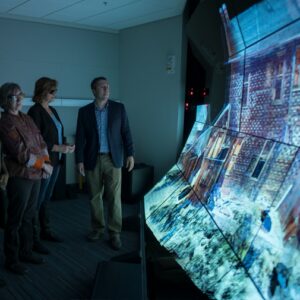- About
- Network
- Community
- Initiatives
- News
- Events
- Blog
- Publications

Wide-Area Visualization Environment (WAVE) System at UC Merced Awarded the 2017 Innovations in Networking Award
Categories University of California RENS & NRENS
Tags award cenic digital divide prp
In recognition of its power to enable members of the UC Merced community to conduct research, experience the world, and deepen their learning through an immersive environment, the Wide-Area Visualization Environment (WAVE) system at UC Merced has been selected by CENIC as the recipient of the 2017 Innovations in Networking Award for Research Applications.
Individuals critical to the development of WAVE and named in the award include Greg Dawe, principal development engineer, CalIT2, UCSD; Rachel Hadley, senior administrative analyst, design and construction, UC Merced; Nicola Lercari, assistant professor of world heritage, UC Merced; and Jeffrey Weekley, director of cyberinfrastructure and research computing, Office of Information Technology, UC Merced.
The Wide-Area Visualization Environment (WAVE) at UC Merced is one of many projects enabled by the Pacific Research Platform. This massive display, consisting of 20 4k-resolution screens, provides student and faculty researchers at UC Merced the capacity to work with the cutting-edge of virtual reality hardware. WAVE is an exciting example of a tool that can reduce the gap between data collection and interpretation and the dissemination of that data to researchers and the public.
“The WAVE at UC Merced is the highest resolution walk-in virtual environment on earth, using 20 4K 3D screens. It is better than 20/20 visual acuity and matches the display to human eyesight, making it often look better than being there. It complements the original WAVE at UC San Diego, and the four library CAVEkiosks at UC Berkeley, UC Los Angeles, UC Merced, and UC San Diego, all tied together for daily telepresence over CENIC and the Pacific Research Platform,” said Tom DeFanti, research scientist at Calit2, University of California San Diego.
The WAVE grows out of a multi-school collaboration and aspires to draw wide participation across disciplines not historically served by this kind of infrastructure, especially humanities disciplines. This virtual reality system also provides opportunities for community engagement and is being used by teachers and students in the Mariposa County Unified School District.
“We are delighted that the WAVE is part of the Pacific Research Platform, which connects the UC campuses with other research universities to create a high-speed network for collaborative science and scholarship. It is the kind of application that all partners in CENIC and PRP were hoping would be developed,” said Louis Fox, president and CEO of CENIC.
CENIC presents the Innovations in Networking Awards at its annual conference to highlight the exemplary innovations that leverage ultra-high bandwidth networking, particularly where those innovations have the potential to transform how instruction and research are conducted or where they further the deployment of broadband in underserved areas.
Related blog posts
CENIC and San Diego Supercomputer Center Create Sustainable Agriculture for California’s Future
CENIC’s networking and services, including CENIC AIR, can be a vital part of preparing new generations of farmers that will apply the latest technology to agriculture by turning the farm into an educational setting and improving the efficiency of farming as a career.
CENIC Members Enable Data-Driven Agriculture: Optimizing Harvests in a Changing Environment
The use of technology in agriculture to increase yield and decrease resources is the focus of an innovative project fueled by CENIC and its collaborative partners: a novel model of precision agriculture in the vineyards.


